Historical data: a catalyst to improve the standard of care in senior living facilities
An organization operating a network of residences for the elderly, dedicated to providing a caring and nurturing living environment, wished to track the demographic trends of its residents over time, including variations in the number of residents. However, their current system didn't allow them to keep historical data, making it difficult to analyze these crucial changes. Visualizing trends over time was essential to better understand the needs and preferences of their residents, and to anticipate the services to be offered. With this need in mind, BEEM implemented a Slowly Changing Dimension (SCD) type 2 solution. This approach makes it possible to track changes in demographic data while maintaining a precise history, taking into account each resident's career path. BEEM worked hand-in-hand with the residences network team to identify the relevant information to be tracked, building a flexible solution perfectly suited to the establishment's demographic tracking and analysis objectives.
Key Obstacles Identified
- Lack of historical tracking: The organization wanted to better understand the demographic trends of its residents, but didn't have a system to keep track of their historical data, limiting in-depth analysis.
- Lack of Trend Visibility: Without historical data, it was difficult for the team to detect significant variations, such as resident progression, age distribution, or length of stay.
- Difficulty in adjusting services: The lack of tracking of demographic trends made it difficult to adapt services to the changing needs of residents, making the adjustment of resources less fluid.










